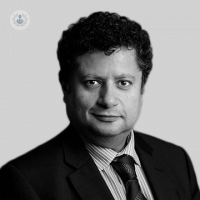Life-saving brain surgery on an awake violinist
Autore:When removing a brain tumour during an awake craniotomy (the opening of the skull), patients need to be woken up so that surgeons can check their ability to perform certain functions. In the case of Dagmar Turner, a professional violinist, it was vital to keep her ability to play the violin. This provided a first for Professor Keyoumars Ashkan, a well-renowned consultant neurosurgeon from the King’s College Hospital in London. Learn about brain tumours, their removal and this remarkable surgery performed by Professor Ashkan and his team.

About brain tumours
A brain tumour is an abnormal growth of cells in the brain. These abnormal growths may be benign (non-cancerous) or malignant (cancerous). Gliomas are one of the most common types of brain tumour and these can be graded from one to four. Grade 1 and 2 are low-grade gliomas and are benign. Grades 3 and 4 are high-grade, which means they are malignant and very aggressive.
Large tumours can result in a variety of symptoms such as
A first: performing an awake craniotomy with a playing violinist
Professor Ashkan had performed countless brain surgeries in his career before meeting Ms Dagmar Turner, a professional violist of the Isle of Wight symphony orchestra, but he had never performed brain surgery while his patient played a musical instrument.
Ms Turner was diagnosed with a grade 2 brain tumour in 2013. Even when tumours are not cancerous, they may need to be removed surgically at some point because their continued growth puts pressure on the brain tissue. Ms Dagmar’s tumour eventually began to trigger seizures and in 2019, she contacted Professor Ashkan to arrange its removal from her brain. The tumour was growing around her frontal lobe and this area of the brain affects the ability to perform intricate and precise hand movements. To ensure that playing the violin was still possible, the tumour needed to be removed safely via an awake craniotomy which took place in February 2020.
What is an awake craniotomy?
An awake craniotomy is a surgical procedure that aims to remove as much of a brain tumour as possible. These surgeries are used to remove cancerous and non-cancerous tumours, particularly when the tumour is in an additionally tricky area of the brain.
What happens during awake craniotomy surgery?
The benefit of an awake craniotomy over a standard craniotomy (in which the patient stays asleep), is that surgeons can monitor the eloquent areas of the brain in real-time during the tumour’s removal.
The patient will be sedated at first but woken up (by an anaesthetist) once the skull has been open and the tumour has been exposed. This is to allow the team of surgeons to test that the brain isn’t damaged during the removal of the tumour. While the patient is waking up, the anaesthetist will confirm with the patient that they feel no pain at all.
The patient becomes a member of the team in regards to checking that healthy tissue remains undamaged. Depending on where the tumour is, different tasks might need to be performed by the patient. If the tumour affects the language controlling region of the brain, the patient may be asked questions that are related to speech. While many patients with a tumour affecting a movement controlling region of the brain are usually asked to move their leg or arm, Ms Turner played the violin.
Professor Ashkan was able to remove 90% of the tumour, which makes for a very successful surgery. Ms Turner has made a full recovery from the operation and has retained her hand movements and coordination, meaning she can continue to play the violin.
Learn how Professor Keyoumars Ashkan can help you with your spinal and brain surgery needs by clicking here


